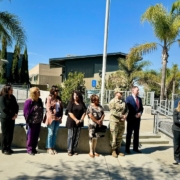Schools Embracing Drug Prevention Programs
San Diego County District Attorney Summer Stephan joined law enforcement leaders, school officials and the California National Guard today to announce the release of a new report outlining recommendations for drug prevention education and anti-overdose efforts in schools. Nearly two dozen schools across San Diego County are already adopting and implementing recommendations from the working group that produced the report which includes five drug abuse prevention and three drug overdose prevention programs.
School-based Interventions for Substance Use and Overdose Prevention lays a foundation for programs in a school setting that can deter or delay the onset of substance use, slow or stop the progression of use and development of substance use disorders and minimize the adverse impact of substance use on students, their families and community, and the economy.
“It’s critical that we educate our youth through compelling and effective curriculum, giving them the tools they need to stay healthy and make decisions that can literally save their lives,” said DA Stephan. “I want to thank the San Diego County Board of Supervisors for their commitment to this issue, the working group that was assembled for the careful consideration they gave to creating this report, and school officials for embracing the drug prevention programs that can make a real difference in the lives of families across San Diego County.”
In October 2022, the San Diego County Board of Supervisors unanimously approved a proposal backed by the County Office of Education to support fentanyl education in county schools, as well as the distribution of naloxone to parents and students and training on its use. The DA assembled a working group of experts that included representatives from the San Diego County District Attorney’s Office, San Diego County Office of Education (SDCOE), San Diego and Imperial Valley High Intensity Drug Trafficking Area (HIDTA), and California National Guard Counterdrug Task Force.
The goal of working group was to study and make recommendations regarding the most effective and proven modalities and programs for building long term resilience in students to live healthy lives free of the negative, and at times, fatal impact of drugs including fentanyl.
“While the HIDTA program is charged with removing deadly drugs from our streets in part by dismantling and disrupting drug trafficking and money laundering organizations, we know that if we are going to be effective in saving the lives of the most vulnerable among us, our youth, then our efforts must include effective, proven life skills and drug prevention curriculum within our schools,” said HIDTA Director David King. “The San Diego Imperial Valley HIDTA is proud to have contributed to the efforts of the working group to identify such curricula and it’s partnerships such as these that make San Diego County a model for the rest of the country.”
“The San Diego County Office of Education has long been a proponent of substance abuse prevention education that incorporates life skills, healthy behaviors, and overall wellness because it’s the right thing for kids,” said Dr. Gloria E. Ciriza, County Superintendent of Schools. “We are fortunate to have strong partnerships with county leaders, law enforcement agencies, and community-based organizations that bring research-validated programs to support our region’s children in staying healthy and safe.”
Fatal overdoses involving fentanyl have surged in recent years in the United States and research shows that deaths among children have increased significantly, mirroring trends among adults. Fentanyl, which is 100 times stronger than morphine, is now present in nearly all illegal substances used by teens. Older adolescent fentanyl poisonings are primarily the result of counterfeit pills containing a lethal dose of fentanyl.
The report found that preventing youth substance use is multifaceted and requires a comprehensive community prevention strategy comprised of synthesized programs, practices, and policies grounded in the best available evidence for greatest impact within individuals, families, schools, and communities. When individuals initiate alcohol and drug use during adolescence, they are much more likely to develop a substance use disorder as a young adult and beyond. Evidence has shown that youth who begin drinking before age 15, for example, experience four to six times the rate of lifetime alcohol dependence than those who remain abstinent from alcohol use until age 21.
Decades of research has shown that much can be achieved through primary prevention interventions delivered during childhood and adolescence to reduce an individual’s later risk for drug use disorders. The report notes that prevention efforts must be initiated in early adolescence and should be targeted towards preventing the use of common substances that are legal for adults but remain illegal for adolescents such as alcohol, nicotine, and marijuana. These substances are often referred to as gateway drugs and may lead to the use of methamphetamine, cocaine, heroin, or opioids that may also contain fentanyl.
Based on the data and research reviewed by the working group, two specific goals were identified:
- Prevent initiation or escalation of substance use in youth 18 and under through evidence-based substance use prevention curricula in schools.
- Prevent overdoses in youth 18 and under using the best available evidence.
It was important for the working group to consider a variety of curriculum options due to the differences in school schedules, structures, and cultures. After careful review of the evidence listed in a variety of registry databases of available programs, and consultation with experts in curriculum analysis and prevention science, five effective drug abuse prevention programs were identified for elementary, middle, and high school populations: Positive Action, Project Towards No Drug Abuse, LifeSkills Training, DARE’s Keepin’ It Real, and Project Alert.

Students at Vista del Mar Middle School participate in one of the programs identified in the report: Rugged Outdoor Physical Experience System (R.O.P.E.S.) is a drug prevention program that focuses on communication and team building to help young people determine when to ask for help and how to receive it.
Many of the curricula outlined in the report are being taught in participating schools by members of the California National Guard Counterdrug Task Force. The National Guard is also committed to assisting schools that opt to have prevention curricula taught by their own teachers by providing training, free of charge, on the implementation and teaching of the identified curricula. SDCOE, with funding from the County of San Diego’s Opioid Settlement Funds, is also working with middle schools in the county to implement Project Alert, one of the research-validated programs highlighted in the report.
After careful review, the working group also identified three programs that show real promise in addressing the goal of overdose prevention:
- Operation Prevention San Diego. This Drug Enforcement Administration program is a free educational program available to schools upon request or at Operationprevention.com.
- “I Choose My Future” is a drug education program offered to schools by the San Diego County Office of Education.
- The working group is also recommending that all schools serving grades 6 through 12 obtain an adequate supply of naloxone.
Schools and organizations that have embraced educational programs recommended by the report include Mar Vista High School, Mar Vista Academy, Sweetwater High School, Barbara Worth Jr. High School, Vista Del Mar Middle School, San Ysidro Middle School, La Mirada Elementary School, Olympian High School, Saburo Murakoa Elementary School, All Tribes Charter School, Southwest High School, Maie Ellis Elementary School, La Paloma Elementary School, Mission Meadows Elementary School, Oceanside High School, Valle Lindo Elementary School, San Pasqual Academy, Smythe Elementary School, The Rock Academy, Ocean View Hills Elementary School, Vista Boys & Girls Club, and Imperial Beach Boys & Girls Club.
The release of the report comes as Red Ribbon Week is about to be observed next week. The DA pointed to the important awareness that Red Ribbon Week brings to drug prevention, which was started to honor murdered DEA Agent Enrique ‘Kiki” Camarena here in San Diego and grew into a national movement. In addition, officials acknowledged the efforts of the County Office of Education under the leadership of former School Superintendent Paul Gothold, as well as the work done in the drug abuse prevention space by retired DEA Agent Rocky Herron.
The full report, School-based Interventions for Substance Use and Overdose Prevention, can be found here.

